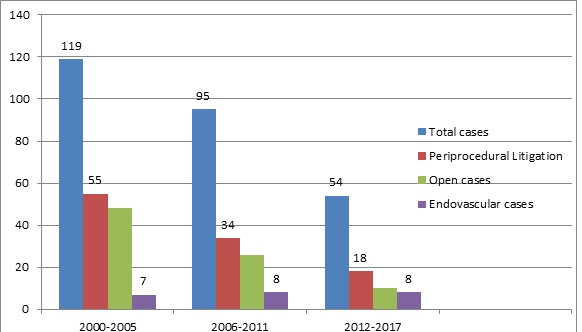Malpractice Litigation In Aortic Pathologies
Indrani Sen, Asad Choudhry, Bernardo Mendes, JIll Colglazier, Fahad Shuja, Randall DeMartino, Thomas Bower, Oderich Gustavo, Manju Kalra.
Mayo clinic, Rochester, MN, USA.
Objective: The objective of this study was to analyze malpractice claims for aortic pathologies in the United States and to assess if there has been a change in operative litigation with evolution of endovascular therapy.Methods: The Westlaw legal database was searched from 2000 to 2017. Keywords included "vascular," "surgery," "endovascular," "stent," "aortic," "aneurysm," and "dissection." Primary injury, aortic pathology, intervention, verdict, settlement amount and specialty of defendant were compared. Cases related to valve replacement, coronary angiography, iatrogenic aortic injury during a general surgical procedure and other non-vascular surgery were excluded.Results: Of 593 search results, 268 were included in final analysis. Aortic pathology was aneurysm in 145 (55%), dissection in 94 (35%), peripheral arterial disease (PAD) in 16 (6%) and trauma in 13 (4%). The lawsuit was peri-procedural in 106 (40%): 63% (71/145) in aneurysm, 15% (14/94) dissection, 54% ( 7/13) trauma and 88% (16/18) in PAD. Procedures were open in 84 (79%), forty (38%) were emergent. The rate of endovascular procedure-related lawsuits was 21%. Primary injury was death in 75%, paralysis/neurovascular 10%, amputation in 7%, other post op complications in 7%. Overall, 52% of verdicts (141/268, including 109 cases where the primary injury was death) favored defendants, 24% (65/268) found for the plaintiff, the median award was $10,063,000 (range 48000- 35000000). Settlements accounted for 20% (54/268), median award was $475,000 (range 25000- 14000000). There was no significant difference in the primary allegation underlying the litigation for various aortic pathologies, time to litigation or award between open and endovascular procedures. A vascular surgeon was the defendant in 6% (16/268) and a witness in 15% (39/268). Mean time from incident to verdict was 4.5 years. Time of filing was available in 99, 20 (20%) suits were filed after 2 years of the year of injury. There was a gradual decline (46-33%) in litigation, but endovascular cases have remained constant (Fig 1)Conclusions: Litigation for aortic pathology is more common for aneurysms and dissection. There has been a gradual decline in litigation for aortic pathology, with a static rate of litigation for endovascular procedures.Fig 1: Distribution of total and periprocedural aortic litigation over study tertiles 
Back to 2020 Abstracts
